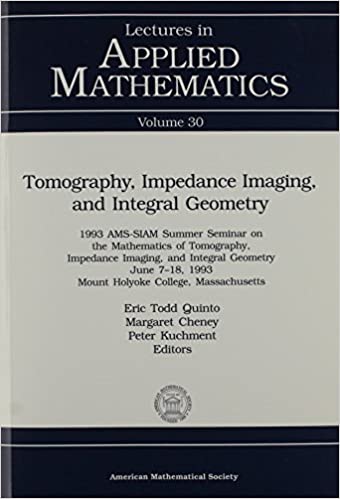

 |

|

The average rating for Tomography, impedance imaging, and integral geometry based on 2 reviews is 3 stars.
Review # 1 was written on 2016-09-14 00:00:00 Martin Cortez Jr. Martin Cortez Jr.This book examines a vast array of animals, birds, insects and monsters known in the sixteenth century. It's actually quite shocking how many animals the people knew about then, far far more than in the fourteenth century! This book was written after Harting's Ornithology of Shakespeare and Bennett's Tower menagerie and borrows a lot from those, but the first section (on quadrupeds) is by far the most useful. Three quotes: {a bit racist but quite amusing} The absence of any mention of the cat in the Bible, except in the Apocrypha, is probably owing to the veneration of this animal by the Egyptians, The Jews would Daturally have unpleasant associations both with doga and cats, as animals that they had seen idolized during their captivity in the land of Pharaoh. But fondness for animals of any kind seems to have been entirely wanting among the Jews. In every early history, except tbe Bible, we meet with some allusion to a favourite horse, or dog, or tame gazelle. No wonder Jessica, freed from the trammels of her Jewish home, could give a turquoise ring for a monkey 1 Another explanation as to the singular scarcity of allusions to animal life in the Bible may be suggested. The Jews apjiear to have been quite indifferent to the beauties of nature. The only traces of admiration of the external world are found in the writings of Job and Solomon. Job was not of Hebrew birth, and Solomon had by his large knowledge gained a wider sympathy with nature thsu his compatriots. It is almost incredible that a nation should wander for forty years through lands rich enough to furnish pasture for vast flocks and herdc, materials for clothing, ornament, and manufactures, and that the chronicle of their Exodus should be absolutely deficient in a single reference to the rich animal life around them. Many species of birds and animals are indeed mentioned, but only to be avoided as unclean. From the list of creatures that might not be used as food, we gather the only information from a Jewish source respecting the fauna of Arabia or Palestine. A similar disregard of natural beauty exists in the Mohammedan scriptures. The poetry of nature animates every other mythology. Love of beauty led the Greeks to personify the waterfall and the rainbow, to find dryads in trees, nereids in ninning brooks, altars in stones, and gods in everything. {interesting} The oil was the ouly produce for which the whale was at first valued. Anderson, in his Origin of Commerce, 1801, traces the introduction of whalebone into Enirland to an accident. Some English ships were sent, in 1593, to Cape Breton on a whaling expedition. At the entrance of the Bay of Saint Lawrence the sailors found no whales, but came to a store of 800 whale fins which had been left on IKn island by some Biscay ship, that was afterwards wrecked. Deeming the flns of some value, the sailors hroaght them home, and we have soon after this date the I first mention of whale bones or fins being used in various articles of ladies' dress. These fins, as explained by-Edge, are the homy laminae adhering to the upper jaw of the whale, and are a substitute for teeth. They are only found in perfection in the Greenland whale and a few other varieties. The spermaceti and white whales possess teeth and no fins. The expression so often used, *• white as whale's bone," arose from the supposition on the part of early English writers that ivory was a portion of the bones of tlie whale. The ivory of the Middle Ages was supplied chiefly by the walrus, whose teeth were brought over in considerable quantities by the Northern fishermen. {interesting The Chimiera, a mythological monstrosity frequently introduced into medieval architecture, was a creature with a goat's body and three heads, one like alion.onelikea j.;oat,andth6 third likeadragon. In Christian art it symbolized deliberate cunning or fanciful illusion. Tho word chimerical in modem usage signifies an idle dream, a castle in tho air, a project that can have no existence but in the imagination. |
Review # 2 was written on 2020-05-02 00:00:00 Ronald Maxwell Ronald Maxwell4.5 stars |
CAN'T FIND WHAT YOU'RE LOOKING FOR? CLICK HERE!!!